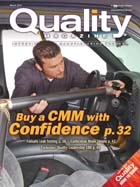

The value of the CMM as a quality control device is relatively easy to see. Yet the process of selecting the correct CMM for an application or for a business is not always so easy.
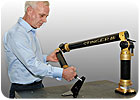
A good place to start is to look not at equipment or software, but to take a good, thorough look at short-term and long-term quality assurance needs. What exactly is a company trying to accomplish by inspection? Is it trying to correct process problems? Perform final checks at the end of a process? Check intermediate steps in a process? Align parts for assembly? Perform inspection by lot or 100% inspection? What will be done with the data obtained from the inspection results? What personnel and skill level is needed to operate the equipment? Where will the equipment be used?
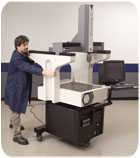
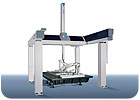
Automatic or Manual?
A good place to start is to look at what a company is producing. Are many different types of parts manufactured on an infrequent basis? Or is it high-volume production of just a few parts? The former suggests the need for a manual device-one that requires an operator to take the measurements. The latter suggests the need for an automatic device, sometimes called DCC, but this simple rule does not always apply.Generally, the larger the parts, the more one starts leaning toward manual devices such as articulated arms and laser trackers. It is simply easier to move a manual inspection device to the part rather than move the part to the machine.
Portable CMMs also are ideal for applications such as part alignment or part-mating to help accurately bring together separate components of very large assemblies such as an aircraft. However, there are situations where an automatic machine is preferable for large parts. For example, if the CMM is to be integrated into a production line for automotive body-in-white, the CMM can perform inspections automatically in-line, or if the part requires hundreds of checks on areas that are difficult to reach by an operator holding a handheld device, the speed advantages of an automatic machine may outweigh the convenience of a portable manual device.

sometimes this step is even automated with automatic loading shuttles.
A manual machine by definition requires one, sometimes two operators in constant interaction with the machine in order to gather measurements. If a few quick checks per part are all that is required, this may not be a big deal. However, the more checks required per part, the more inefficient a manual device can become because of operator fatigue and other factors.
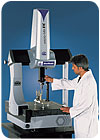
Further, the accuracy of manual devices is highly dependent on technique and the skill of the operator. Automatic CMMs are generally more accurate, but programming technique can have a significant effect on accuracy of even an automatic machine. Matching device accuracy with application requirements is a far more realistic exercise-one that is best done in consultative fashion with each vendor.
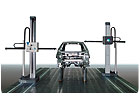
Location, Location, Location
Another important consideration is where the CMM will be used. In the case of a manual portable device such as an articulated arm or laser tracker, the answer could easily be “anywhere I need it.”For high-volume, repetitive use where an automatic CMM is a better choice, the location question is not so clear-cut. In times past, CMMs were relegated to an air-conditioned room somewhere off the production floor. These days, automatic CMMs can be placed in many locations: in machining cells, integrated into a production line or in a freestanding enclosure on the shop floor.
Remember that the closer one gets to inspecting recently produced parts, the more one has to be aware of the thermal characteristics of the parts themselves. Even if the CMM is temperature compensated, the thermal expansion or contraction of the part itself must be taken into account. Many CMMs have part temperature sensors that assist with this.
Another consideration when inspecting close to the point of production is vibration. Many CMMs have passive vibration dampening features, which help isolate the measuring device. There also are active vibration systems available for greater dampening capability. Nonetheless, one may want to think twice before putting the measuring machine right next to the punch press.
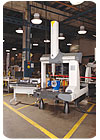
One final note on location. It may seem terribly obvious, but make sure that the new purchase will fit through all the doorways it must traverse en-route to its final destination. And make sure there is enough ceiling clearance, too. If room or doorway modifications are necessary to get the CMM into its location, this should be known up-front, not when the installer is on site trying to set it up.
Soft Factors
Soft factors refer to the ownership experience. Often a purchase decision is based mainly on immediate factors-price and availability. However, the CMM is a durable good; some might say an extremely durable good, judging from the number of CMMs that soldier on after two decades of service. A manufacturer will live with this purchase for a long time, so the capability of the vendor to serve one’s needs for many years is worth careful consideration. In other words, what kind of support will a manufacturer need and how does the vendor provide it?Training is an essential element. Many pieces of equipment sit around unused because nobody knows how to operate them. Consider the type of available training, where it is conducted and how often. Is on-site training available? While it can be tempting to conduct all training in one’s own facility, with its own equipment and own parts, this experience can be limiting for the students. Worst case, when they are done, they will only know how to inspect the parts they were taught to inspect. Plus, on-site training has all the normal distractions of the workplace interfering with the learning experience.
With a classroom course, the student is free from the normal distractions of the office, plus the training will focus on principles and applications, not specific parts. Classes with mixed attendance from different companies offer the opportunity for informal benchmarking as students learn how other companies apply inspection equipment to their processes. A good combination training program could send the primary operators to a classroom course at the equipment supplier, and then purchase a week of additional on-site training later. Remember, too, that employee turnover is a constant issue in modern companies, so training will likely be necessary on an ongoing basis.
Additionally, quality control equipment needs regular calibration and certification. Ask how many service engineers the company has to assist customers, and find out if any are local. Companies often offer bundled preventative maintenance, service hours and calibration packages that can be purchased along with the machine for convenience; no need to get a purchase order later if the machine needs immediate service.
Technical support is another soft factor. How many people are dedicated to customer support? What type of telephone support is available? How many application specialists are available to assist, what types of services do they offer and where are they located? Is there an online forum to ask questions of other users and find solutions to common questions?
Probing
Even when one has settled on the type of CMM, usually there is an additional selection of probing devices to consider. Probing technology is the subject of extensive feature-benefits tradeoffs as well, and for the sake of brevity, such a discussion will have to be the subject of another article.Briefly, one must decide the type of probing technology that is best for the application. Probing generally falls into three categories:
• Contact-point where a single point is inspected at a time
• Contact-scan where the probe touches the part and moves while maintaining continuous contact with the part
• Noncontact scan where data is collected in a continuous manner without touching the part. This is often done with a laser, but other technologies exist as well.
Some applications benefit from a hybrid metrology approach, where different types of probing technologies are combined in a single inspection, for example, contact probing for alignment and noncontact scanning for surface evaluation.
Most, but not all, of the factors that should be evaluated when choosing a CMM have been covered. Hopefully, the discussion has revealed the incredible range of variables that must be weighed before making a final purchasing decision. An experienced consultative sales engineer will guide one through many of these considerations, and help evaluate the various tradeoffs as they apply to one’s processes and products. In the end, the best advice is to conduct a thorough, preliminary assessment before contacting vendors. Q
Bill Fetter is director of marketing and commercial services for Hexagon Metrology Inc. (North Kingstown, RI). For more information, call (800) 343-7933, e-mail [email protected] or visit www.hexagonmetrologyus.